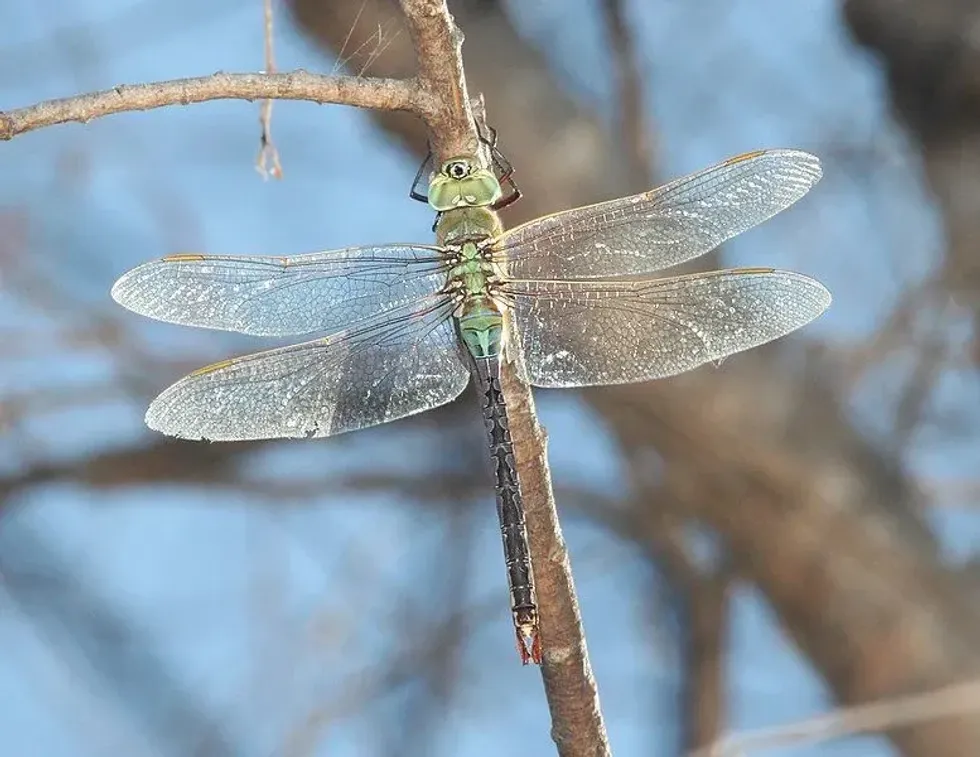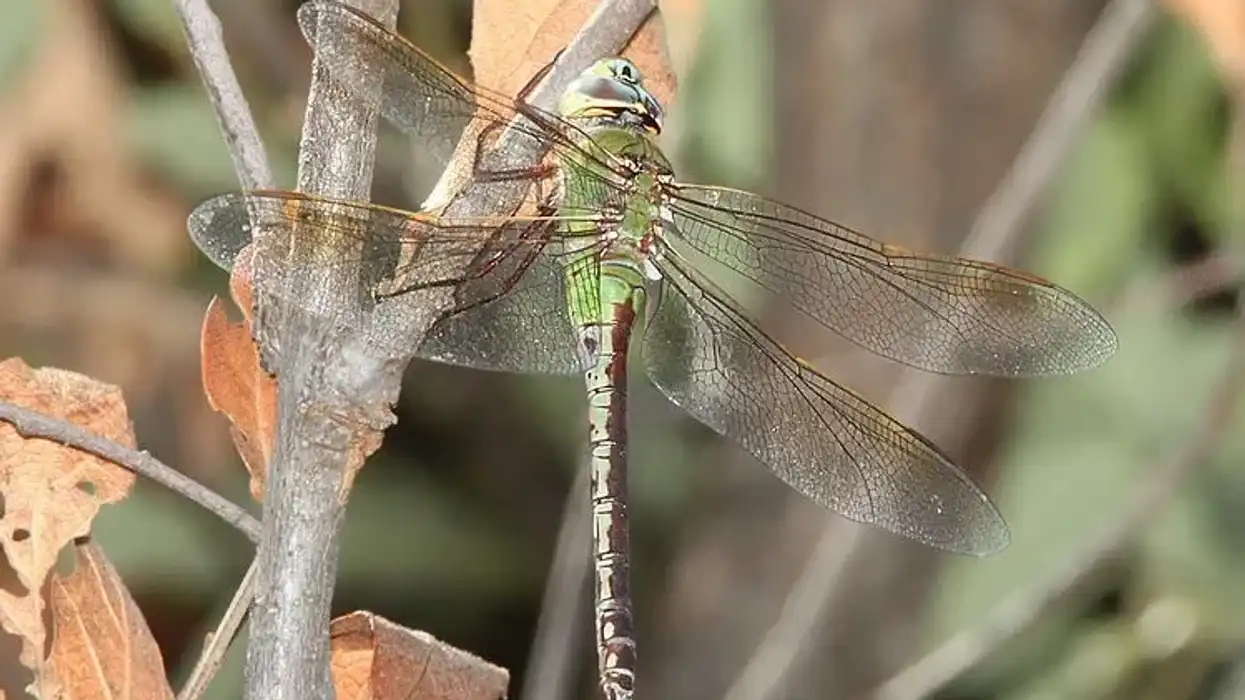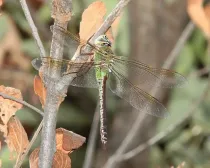Fun Common Green Darner Facts For Kids

The green darner (Anax junius) species, often known as the common green darner because of its similarity to a darning needle, is a kind of dragonfly in the Aeshnidae family. It is one of the most common and prolific species in North America, and it also extends south to Panama.
It is widely recognized for its long migratory distance from the northwestern United States to Texas and Mexico. This species is also found in the Caribbean, Tahiti, and Asia from Japan to China's mainland.
It is the official bug of the American state of Washington.
The green darner is one of the biggest dragonflies still alive today. Green darner, snake doctor, and darning needle are some of the other names for the green darners.
If you like reading about arthropods, take a look at our Sally lightfoot crab and scorpion facts.
Common Green Darner Interesting Facts
What type of animal is a common green darner?
The common green darner (Anax junius) is a dragonfly.
What class of animal does a common green darner belong to?
Common green darners belong to the class Insecta, phylum Arthropoda, order Odonata (Dragonflies and Damselflies), genus Anax, species Junius, and family Aeshnidae.
How many common green darners are there in the world?
The exact number of adults of dragonflies and damselflies is not known. Despite this, they are the most common and largest darner in North America.
Where does a common green darner live?
Green darners like freshwater environments such as ponds, lakes, slow-moving streams, and vernal pools. This dragonfly, like the monarch butterflies, is well-known for its famous journey from the northern United States to humid climatic regions such as Mexico and Texas.
It may also be found in Tahiti, the Caribbean, North America, and Asia from Japan to China. In spring they migrate towards the north.
What is a common green darner's habitat?
Green darners favor freshwater environments such as ponds, lakes, slow-moving streams, and vernal pools. The green darner has a wide distribution in North America, stretching from Alaska and southern Canada to Central America. Anax junius may also be found on islands in this geographic area, such as Bermuda, the Bahamas, and the West Indies.
Who do common green darners live with?
Green darners migrate. They, like birds, respond to a proper weather front—cold fronts for the southern voyage and warm fronts for the considerably less visible northern trip.
The voyage south may take many weeks of stop-and-start flight (averaging 7 mi (11.2 km) per day but capable of much more depending on the wind), and they may be accompanied by black saddlebags and variegated meadowhawk dragonfly. They move rapidly, sometimes in massive swarms that might take hours or days to pass a fixed place.
How long does a common green darner live?
Adults are expected to survive just a few weeks to a little more than a month after reaching maturity.
How do they reproduce?
A male common green darner (Anax junius) often takes a female to initiate mating, but the female decides whether or not to mate. With his cerci, the male grabs the female by the top of the head or prothorax.
The couple flies away from the lake and usually lands on vegetation to mate. Green darners are polygynandrous, with both males and females mating many times with various mates.
Females frequently have markings on their pronotum or eyes from being grabbed by males during copulation; males may also have these marks. Residents in the north generally mate in the late summer, between July and August.
In migratory populations, individuals who have gone north mate in June, whereas those who have traveled south mate in late autumn. Mating occurs throughout the southerly migration as well.
The egg is sheltered in the stem until it hatches, at which point the small nymph creeps out into the water. They differ greatly from the aerial adults in that they are shorter, brown/green-colored, and gilled for life in the water. When the eggs hatch and the baby naiads emerge, they resemble little lobsters rather than darners.
What is their conservation status?
The common green darner (Anax junius) is a species of Least Concern with a steady population.
Common Green Darner Fun Facts
What do common green darners look like?
They are most easily identified by their bright green thorax. Both male and female green darners have a unique blue and black bulls-eye marking on the forehead, right in front of their huge, compound eyes. Both sexes have the green thorax.
A black line extends through the middle of the dorsal surface, indicating the lengthy abdomen. The abdomen of young common green darners of either sex appears red or purple.
Mature males have a brilliant blue abdomen, although it can become purple in the early morning or when temperatures are cold. The abdomen of fertile females is green, matching the thorax. Older darners' wings may have an amber hue to them.

How cute are they?
Arriving on the scene approximately 300 million years ago, dragonflies were one of the first creatures to inhabit this planet. They've had plenty of time to master the skills of flying, hunting, and simply being incredible.
It is visually stunning, with delicate, lacy wings that gleam in the sunshine and vivid metallic hues on their bodies. Because certain species are fairly big, they are excellent creatures to observe, photograph, and even film.
They are interesting insects due to their vibrant colors and beauty. The green darner is as lovely as butterflies, but it has an added benefit: it consumes millions of mosquitoes!
How do they communicate?
Dragonflies have excellent eyesight, thanks to their big, well-developed eyes. Their eyes are so big that they wrap around their heads and provide a nearly 360-degree view, albeit they cannot see much above or below them.
They can sense movement readily, allowing them to identify aerial or terrestrial prey and find mates. Dragonflies have the ability to sense a wide spectrum of colors, including UV light.
When migrating, common green darners may be able to use plane polarised light to identify which way is south. When mating, eyesight is crucial for recognizing partners, but so is a tactile connection.
How big is a common green darner?
The common green darner dragonfly is one of the biggest living dragonflies, with males reaching 3 in (76.2 mm) in length and a wingspan of up to 3.1 in (78.7 mm). Dragonflies aren't particularly large insects, either as larvae or as adults.
How fast can a common green darner fly?
Dragonflies can fly at speeds ranging from 22-34 mph (35.4–54.7 kph). Their average speed is 9.9 mph (16 kph). Common green darner dragonfly is a fast flyer that rarely sits.
During the breeding season, adults fly low over ponds or bogs. This species migrates periodically, creating huge swarms in the fall while going south. Green darners are among the first species to emerge in spring in northern environments.
How much does a common green darner weigh?
A typical darner weighs just 0.014 oz (0.4 g). A gigantic darner will be somewhat heavier. The common green darner size is more.
What are the male and female names of the species?
Male and female dragonflies do not have distinct names. They're simply called common green darner female and common green darner male.
What would you call a baby common green darner?
Depending on where they are in the dragonfly life cycle, a young dragonfly is referred to as a nymph or larval.
What do they eat?
Green darners are predators for their entire lives. Adult captures insects in the air and may consume them in mid-flight or when resting. They can also pick up prey from the ground or off a leaf, and they have been known to stake out bee colonies.
They are migratory. Other aquatic insects including, tadpoles, and even small fish are preyed upon by the big aquatic nymphs. Other flying insects caught by adult green darners include butterflies, bees, flies, and even tiny dragonflies.
Are they dangerous?
Large groups of the adult common green darner dragonfly have been observed feeding on honey bees in bee yards, particularly queens and drones on nuptial flights. This has resulted in significant financial losses for beekeepers, particularly after a particularly severe outbreak in 1941. Massive swarms have the ability to wipe out many colonies.
Would they make a good pet?
The green dragonfly is entertaining to raise but difficult to manage as a pet. They are large-winged insects that may reach a length of 4 in (10.1 cm).
They are also known as skimmers because of their ability to skim across ponds and other bodies of water. A nymph is a baby dragonfly that lives in water.
Nymphs crawl to a dry place and lose their skin when they are ready to leave the water. Then they fly away like the dragonflies that most people are familiar with.
Collect some water and pick out the nymphs with an aquatic insect net. It is preferable not to introduce a new species that may become invasive. Feed mosquito larvae, other water insects, worms, and even aquatic vertebrates like tadpoles and tiny fish to the nymphs.
Wait a few weeks or months for the nymph to mature and leave the water. Make a few square feet of area for the dragonfly to fly about in.
Allow the dragonfly to catch its prey by releasing live insects into the tank or enclosed area. Introduce the dragonfly to other dragonflies in order for them to reproduce.
Allow a pregnant female dragonfly to lay her eggs in a calm body of water. Make certain that the freshly hatched dragonflies do not fall into the water, since this may prevent the exoskeleton from solidifying.
Did you know...
If a dragonfly bug lands on your palm, it might be seen as a sign of good fortune, though this is not factually proven.
Many people think that these insects only survive for one day. This, however, is not the case. A dragonfly's life cycle is around six months long, from egg to adult mortality.
The common green darner is frequently the first dragonfly species spotted in the spring and can still be found in late October. The abdomen may become purple or green in chilly temperatures. Green darners move in groups in the spring and fall.
Why are green darners important?
Dragonflies, such as the green darner, are essential predators in aquatic environments. Some insects that are hazardous to people, such as mosquitoes, and agricultural pests, like Mexican bean beetles, are frequently fed on by common green darners.
However, these dragonflies are unlikely to produce considerable pest reduction and are not a crop control strategy other than natural predation. Dragonfly nymphs can be utilized as bioindicators of water quality in some cases; common green darter nymphs may also have the potential to act as bioindicators, however further study is needed.
Why are dragonflies called darners?
Dragonflies are called 'darner' because folklore told that their long, darning needle-like abdomen sewed people's lips or ears shut. They were considered to be the Devil’s darning needles. This, however, was just a myth that was told and is not true but led to their common name.
Here at Kidadl, we have carefully created lots of interesting family-friendly animal facts for everyone to discover! For more relatable content, check out these morpho butterfly facts and purple emperor butterfly facts for kids.
You can even occupy yourself at home by coloring in one of our free printable common green darner coloring pages.
We Want Your Photos!
More for You
Bachelor of Fashion Technology specializing in Fashion Merchandising

Shivangi PandeyBachelor of Fashion Technology specializing in Fashion Merchandising
Shivangi is pursuing a Bachelor's degree in Fashion Technology from the National Institute of Fashion Technology. She has a strong passion for the English language and communication, with a keen interest in fashion blogging. Shivangi's educational background and interests complement her ability to create engaging and informative content for readers.
Postgraduate Diploma in Management

Sakshi RaturiPostgraduate Diploma in Management
Sakshi has experience in marketing strategy, social media planning, and recruiting industry experts for capstone projects, she has displayed a commitment to enhancing their skills and knowledge. She has won multiple awards, including a Certificate of Appreciation for Creative Writing and a Certificate of Merit for Immaculate Turut, and is always seeking new opportunities to grow and develop.
Disclaimer
1) Kidadl is independent and to make our service free to you the reader we are supported by advertising. We hope you love our recommendations for products and services! What we suggest is selected independently by the Kidadl team. If you purchase using the Buy Now button we may earn a small commission. This does not influence our choices. Prices are correct and items are available at the time the article was published but we cannot guarantee that on the time of reading. Please note that Kidadl is a participant in the Amazon Services LLC Associates Program, an affiliate advertising program designed to provide a means for sites to earn advertising fees by advertising and linking to Amazon. We also link to other websites, but are not responsible for their content.
2) At Kidadl, we strive to recommend the very best activities and events. We will always aim to give you accurate information at the date of publication - however, information does change, so it’s important you do your own research, double-check and make the decision that is right for your family. We recognise that not all activities and ideas are appropriate for all children and families or in all circumstances. Our recommended activities are based on age but these are a guide. We recommend that these ideas are used as inspiration, that ideas are undertaken with appropriate adult supervision, and that each adult uses their own discretion and knowledge of their children to consider the safety and suitability. Kidadl cannot accept liability for the execution of these ideas, and parental supervision is advised at all times, as safety is paramount. Anyone using the information provided by Kidadl does so at their own risk and we can not accept liability if things go wrong.
3) Because we are an educational resource, we have quotes and facts about a range of historical and modern figures. We do not endorse the actions of or rhetoric of all the people included in these collections, but we think they are important for growing minds to learn about under the guidance of parents or guardians.







